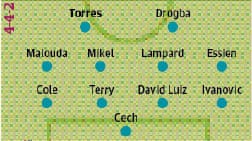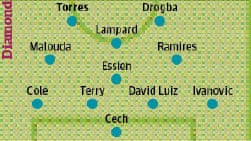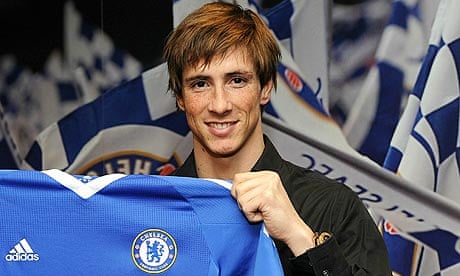Fernando Torres's £50m arrival at Stamford Bridge could prompt Carlo Ancelotti to stray from the tried and tested 4-3-3 formula that helped Chelsea to the Double last season. Both Torres and the man he will eventually replace as this team's attacking talisman, Didier Drogba, will expect to play in the months ahead. Ancelotti must conjure a formation that gets the best out of both. There are various approaches the manager could adopt.

There is scope to take on a conventional 4‑4‑2 with Torres and Drogba as an orthodox front pairing, Florent Malouda on the left and Ramires or Michael Essien – neither of whom feels like an ideal right-winger – on the right. Perhaps significantly, Drogba claimed in his autobiography that he enjoyed playing with Andriy Shevchenko in a duo that allowed him to share the burden of work. Torres, likewise, has struck up an understanding with David Villa with Spain and excelled for Liverpool against Chelsea at Anfield in November when paired with Dirk Kuyt.

Similarly, Ancelotti could revert to the diamond formation he pursued in his first few months in England, asking Malouda and Ramires to sit slightly narrower either side of Essien or Mikel John Obi in an anchor role, Frank Lampard at the tip and the full-backs to provide the width. The problem, of course, is that the diamond stifled Lampard last season, with the midfielder lost in a cluttered midfield and starved of space into which he could charge.

One suspects, however, that Ancelotti's instinct will be to tweak the system that worked so well for him last season – if not quite so successfully during Chelsea's dismal recent run – and thereby avoid falling into the trap of switching the entire formation to accommodate a big‑money arrival, as José Mourinho had to with Shevchenko in 2006. The Italian has spoken of his reluctance to ditch a formation players have grown so used to, which could mean Torres playing through the centre of his forward trident with Malouda on the left and Drogba asked to drift wide. That may sacrifice some of Drogba's more predatory instincts, but it may benefit the team's rhythm overall.
The Ivorian has edged wider naturally this term, perhaps as a result of the bout of malaria that sapped his energy as winter set in and denied him the explosive pace that once laced his game. Certainly, that goes some way to explaining the relatively small number of goals he has scored compared with last year. He is often caught drifting deeper or wider these days, and could always interchange with Torres if required, swapping to ensure one of the team's predators is threatening the six-yard box. Regardless, the fall guy still appears to be Nicolas Anelka who, unless Malouda's form deteriorates yet further, may now confront a bit-part role in the Champions League and become key for the FA Cup, in which Torres is ineligible.

